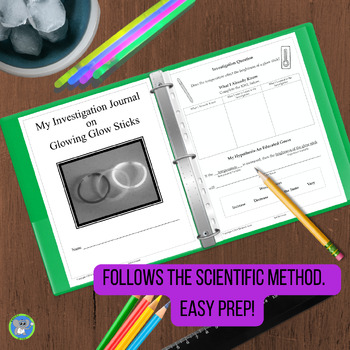Chemical Reactions Glow Stick Science | Investigate Light | Grade 4 5
- PDF
- Easel Activity
Also included in
- Bundle and SAVE on this collection of our favorite science and STEM holiday activities. You will get 7 project-based units that are popular for Halloween, Thanksgiving, Christmas, Valentine's, Saint Patrick's Day, and Easter. They meet the standards and can be used anytime, too!Each Unit IncludesAnPrice $32.92Original Price $41.15Save $8.23
- Engage students with the science of glow sticks. All grade levels teach the same concept but differentiate by age and abilities. This enables a teacher to teach the same concept at the same time. Great for the science lab teacher and homeschool family. By purchasing this bundle, you are SAVING 2Price $8.40Original Price $10.50Save $2.10
Description
Excite students by using glowsticks to investigate chemiluminescence and the speed of a chemical reaction. This experiment uses simple supplies, includes detailed directions to guide the teacher and students, and creates a memorable experience. NGSS Aligned, fun, and perfect for Halloween.
Students will discover chemiluminescence and the speed of a chemical reaction.
They will follow the scientific method to answer the question:
Does temperature affect the brightness of a glow stick?
The journal meets the NGSS
- 4th Energy
- 5th Grade Structures and Properties of Matter
- 3rd-5th Science and Engineering Practices
Teachers will like its’ ease of use, simple materials, and background information. They will enjoy watching the students get excited as the glow sticks dim and brighten. Students will enjoy performing a hands-on activity and being able to make a glow stick get brighter. They will love uncovering the science behind the glow.
This hands-on Investigation and Teacher guide includes:
- Correlation to the NGSS
- Background information with station activity ideas.
- Investigation journal following the scientific method.
- All About the Glow Students Page
- Assessment Page
- Answer Key
- Rubric
Supplies Needed
Glow sticks, Water, ice, Hot Water, Tall Glass or Mason Jar, Paper Towel Roll, Clock or Stopwatch, Paper Towels
Great for science classes, science camps, Halloween, homeschool, clubs, and science fairs. Many use it as a class science fair project.
This investigation is part of a series. The k/1 journal has 2 variables and more guidance. The 2nd/3rd-grade version expands to 3 variables, graphing, and more writing. The 4th/5th-grade version has 3 variables, expands the number of trials, and expands on expectations.
All are available for a bundle discount
Investigate Glow Stick Brightness with Grades K-1
Glow Stick Brightness Investigation For 2nd/3rd Grade
Bundle: Investigating The Brightness Of Glow Sticks: K-5th Grade Experiment
Digital and Distance Learning Approved. This experiment uses simple supplies and can work well for distance learning or digital activity. The teacher can perform the experiment during a virtual class, and students can have the choice to perform it with you. In the classroom, students can easily perform it at their own pace. The file is a PDF but comes with a pre-created Easel by TpT overlay. We added text boxes and tips for completing it online. Click "Open in Easel" on the product page to get started. It can be added to your Google Classroom as an assignment. Students can also print and complete it. A science lab teacher can also assign all the grade levels, allowing families to conduct the experiment together. (See the Bundle.) You can send the overlay as a link to Google accounts if you don't have Google Classroom. If that is not possible, use the PDF in a program like Kami extension to create an online version with text boxes. We already did it for you in Easel. If creating at-home kits, just add a couple of glow sticks. How Fun!
You might also like
Gravity And Motion: Investigate And Explore Marble Roller Coasters
Chemical Eruption Investigation: Baking Soda And Vinegar Experiment For 4th-5th
Remember leaving feedback earns you points toward FREE TPT purchases. I love hearing how the investigation went.
Also, follow me and be notified when new explorations are uploaded and deals.
Please contact me with any questions! I am here to help.
Yours in Science,
Kimberly Scott
All parts are copyrighted. Please see the Terms of Use in the download.








